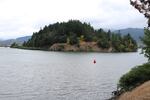
Aerial view of Bradford Island located near Cascade Locks on the Columbia River.
Courtesy of Oregon Department of Enviromental Quality
The Columbia River’s Bradford Island moved a step closer on Wednesday to getting on the nation’s list of top-priority toxic cleanup sites, following the Biden administration’s proposal to designate it as a Superfund site.
The Environmental Protection Agency announced the move on Wednesday for the island at the Bonneville Dam site, where the U.S. Army Corps of Engineers dumped toxics for decades.
The proposal was seen as a belated move to bring environmental justice to the Columbia River’s Native American tribes, which have traditionally fished these waters about 40 miles east of Portland. The proposed Superfund listing follows years of pressure from Indigenous communities to clean up waters that have contaminated the river’s fish.
Rose Longoria from the Yakama Nations said the tribe is hopeful that after so many years, the EPA will finally get Bradford Island cleaned up.
She said the EPA needs to " fulfill their obligation to honor and protect the Columbia River and the resources that reside in the Columbia River.”
Oregon’s last Superfund site to be listed was North Ridge Estates, an asbestos-contaminated housing development in Southern Oregon, in 2011. If Bradford Island is added to the list, Oregon will have 13 sites listed with Superfund status. Superfund status allows the EPA to begin a process to clean up a contaminated site with the government’s highest legal standards and create the funds to do so.
“This Superfund listing is a huge win for the people of Oregon and Washington, for fish in the Columbia, for our sovereign tribes and for the environment,” Oregon Department of Environmental Quality Director Richard Whitman said in a press release statement.
This decision comes as environmental, health, conservation groups, lawmakers, the Confederated Tribes and Bands of the Yakama Nation and environmental state agencies have requested the federal government for the last two years to list Bradford Island as a Superfund site after the Trump administration declined to do so.
Now those same groups are calling this proposal a big win and a first step in getting Bradford Island on the Superfund list.
“This is a game changer,” Columbia Riverkeeper legal and program director Lauren Goldberg said in a press release statement. “Superfund listing will kickstart a cleanup of this forgotten waste dump. We applaud the Biden administration and EPA for standing up for the people harmed by toxic waste.”
During President Joe Biden’s first month in office, he signed an executive order that included a long list of climate and environmental policy priorities, including the creation of a new task force focused on tackling environmental injustices. One of those priorities: cleaning up legacy pollution sites, with an emphasis on those where decontamination will benefit disadvantaged communities. Bradford Island fits that bill.

East end of Bradford Island where the U.S. Army Corps of Engineers dumped toxic materials into the river from 1942 until 1982 contaminating soil, water and resident fish in the area.
Monica Samayoa / OPB
Following the start of construction of Bonneville Dam by the Army Corps of Engineers in the 1930s, Bradford Island was used by the Corps as a dumping site for more than four decades. The Corps dumped and buried electrical equipment and other debris in the area, resulting in high levels of toxic pollution. Trashed materials containing polychlorinated biphenyls, or PCBs, contaminated the soil, water and fish in the area.
Once PCBs are present in the environment, they do not break down easily and can build up in the tissues of fish. PCBs have been known to have harmful effects on human health. Fish consumption is one of the most common ways the toxic chemical enters the human body.
Both Oregon and Washington health agencies have issued health advisories to avoid eating resident fish at Bradford Island because of high PCB levels. Those include bass, bluegill, carp, catfish, crappie, sucker, sturgeon, walleye and yellow perch.
In the 1980s, the Corps took its first steps toward cleaning up the area but the progress has been very slow. Cleanup efforts ended in 2007, when the Corps removed sediment along Bradford Island’s shoreline.
The Yakama Nation’s Longoria said cleaning up sites like Bradford Island can be complex and time consuming. The Bradford Island cleanup has been further hampered by the lack of a sufficiently defined and structured plan, said Longoria, who works as the Superfund projects manager for the tribes’ fisheries program.
“We wanted to make sure that the clean up was being done appropriately and that we were addressing all the various issues,” she said. “Based on additional sampling that happened after that removal action, the conditions did not improve in fact they got worse.”
Tissue samples from resident fish conducted by the Oregon Department of Environmental Quality in 2011, showed the levels of contamination were still too high for resident fish and people who eat them.
To be formally listed as a Superfund site, Bradford Island must be found to meet certain requirements and undergo a public comment period. The U.S. Army Corps of Engineers would remain as the federal agency responsible for the cleanup, with the EPA overseeing its work.
Corps spokesperson John Morgan said remediation efforts will continue at the site as it goes through the listing process and they welcome EPA expertise in cleaning up the site.
